Last updated 04/14/2025.
I got tired of looking up various things in random websites flooded with ads and bloat just to figure out how to turn off all the annoying ads and "features" enabled in Windows by default, so I decided to make this guide to have everything you need to do after installing Windows 10 or 11 in one place.
The guide focuses mostly on Windows 11 since it's the main one now, but most of it should apply to Windows 10 also. A few things might be moved around slightly between the versions though. I'd suggest going with Windows 11 nowadays just because Windows 10 will lose support in under a year as of writing. So much for the "last" Windows version.
Tired of searching for a document on your computer, only for Windows to just look it up on Bing? And even if you did want to do a Web search from the taskbar for some reason, it always opens the search in Bing and Microsoft Edge regardless of what your default browser/search engine is set to. Disable this annoying "feature" with a simple registry key.
Note that this is not possible through the group policy editor in any version of Windows; a similar setting exists but it doesn't work.

Don't add or modify any other registry keys. You'll need to restart the PC for this change to take effect.
"Windows welcome notifications" are basically full-screen ads that show up randomly when you start your PC. They usually try to convince you to switch to Microsoft Edge or sign into a Microsoft account or whatever else Microsoft wants to push on you today. There's no way to disable them when they pop up, and you can only dispel them for 3 days at a time. But you can get rid of these pesky notifications for good by simply unchecking a few boxes in Settings.
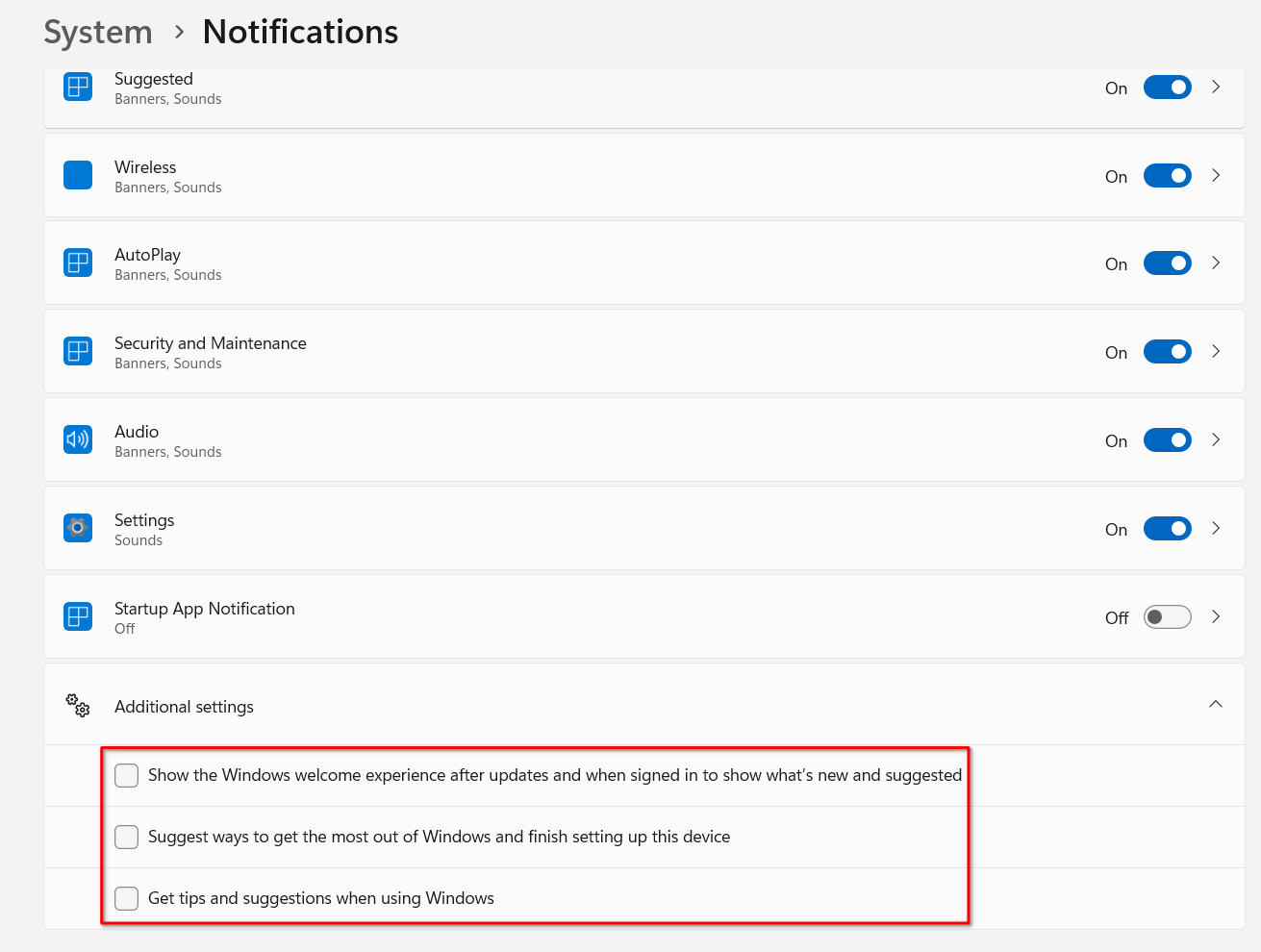
Navigate to "System > Notifications > Additional settings" in the Settings app to find this page.
Out of the box, Windows will show random web links and advertisements on the lock screen while the computer is locked. To disable this, go to "Personalization > Lock screen" in the Settings app.
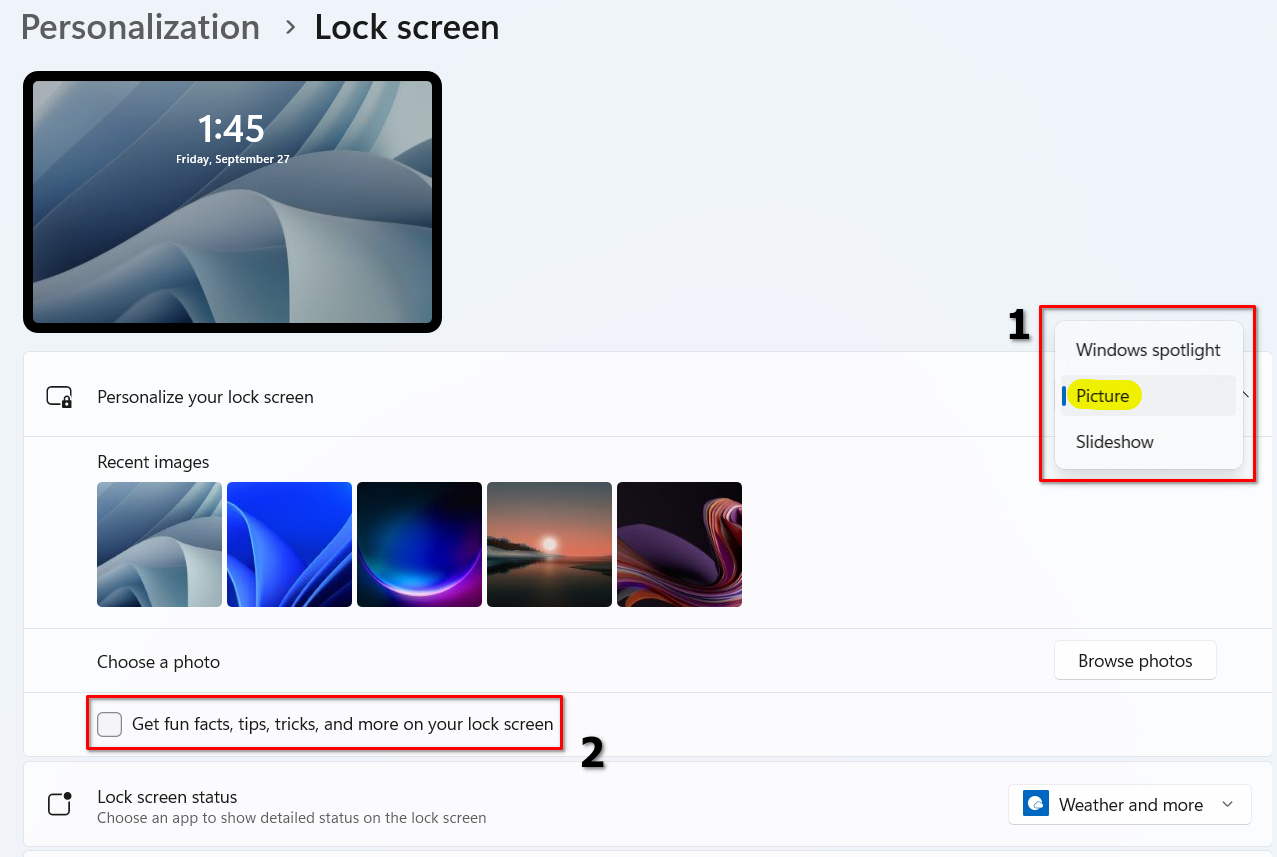
The "Personalize your lock screen" setting will be set to "Windows spotlight". Change it to "Picture" and uncheck the new setting that appears. You can also set your own custom lock screen image from here, similar to setting a wallpaper.
If you want, you can also disable the widgets that appear on the lock screen by changing "Lock screen status" from "Weather and more" to "None".
By default, Windows will show "Recommended" apps occasionally in the Start menu. To evict these uninvited guests from your Start menu, simply navigate to "Personalization > Start" in the Settings app.
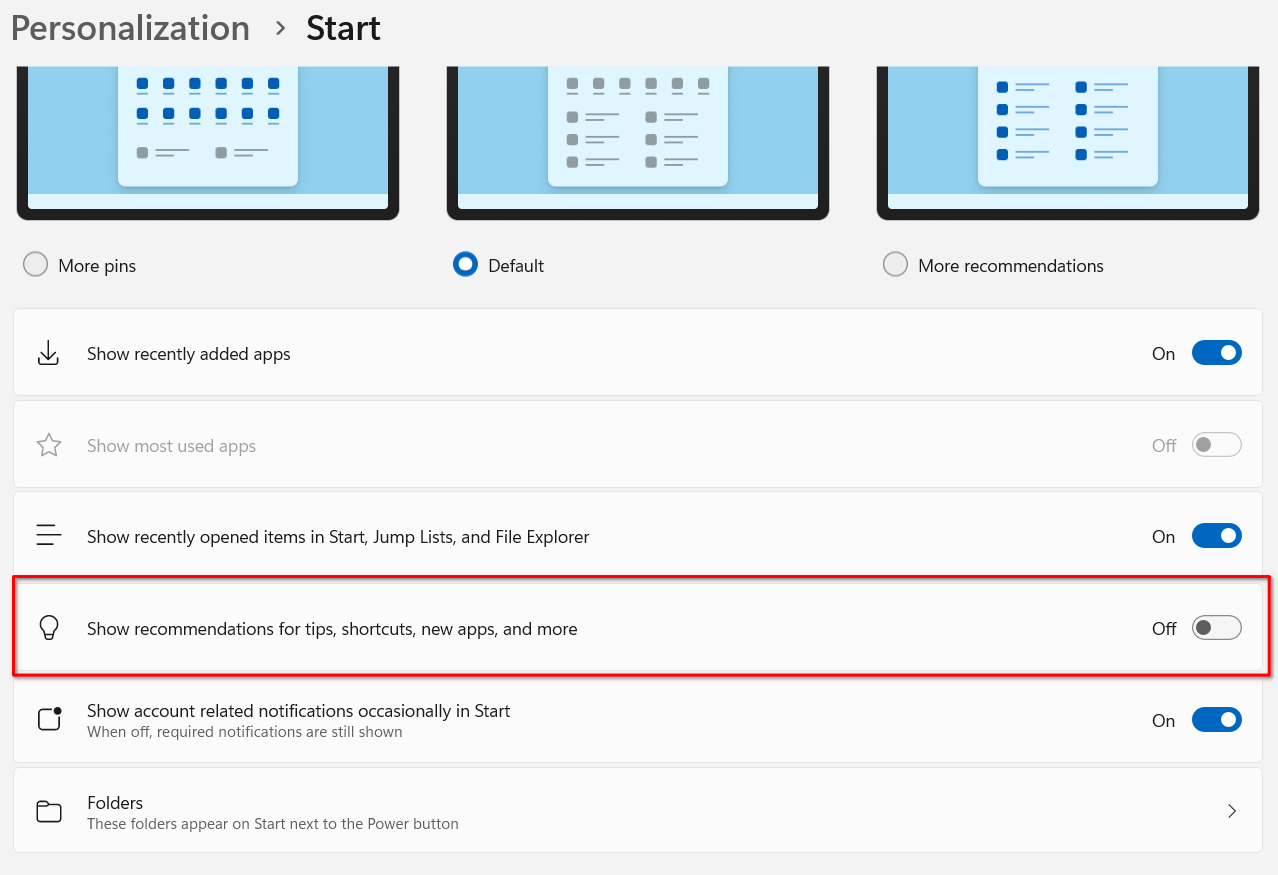
Don't want useless widgets taking up space on the taskbar? You can customize what icons appear in the Taskbar at "Personalization > Taskbar" in the Settings app.

You can also get a cleaner look by doing away with the graphic that shows up in your Search bar by disabling Search Highlights in "Privacy & security > Search permissions".
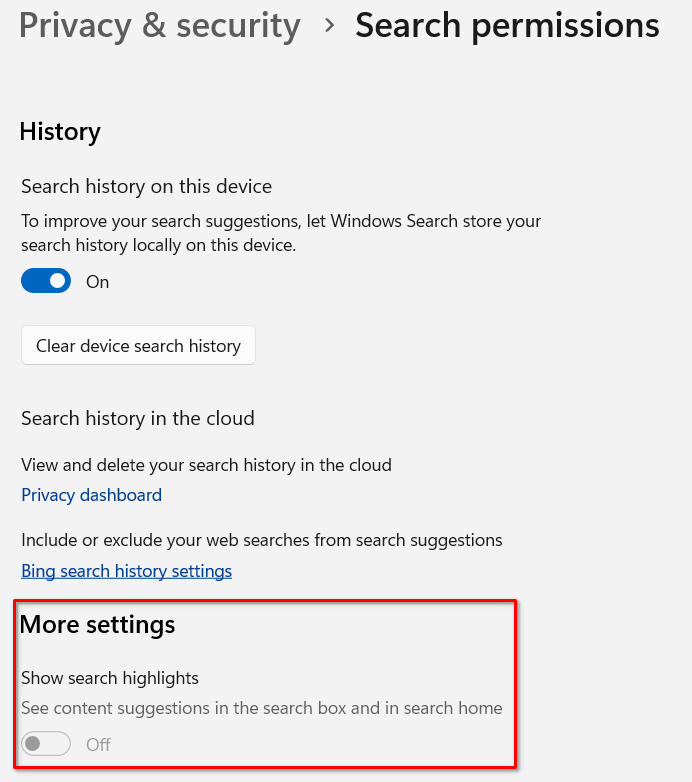
Windows 11 changed where the Start button and taskbar icons appear to the center of the screen. If you'd rather not relearn decades of muscle memory for no reason, you can change it back at "Personalization > Taskbar" under "Taskbar behaviors".
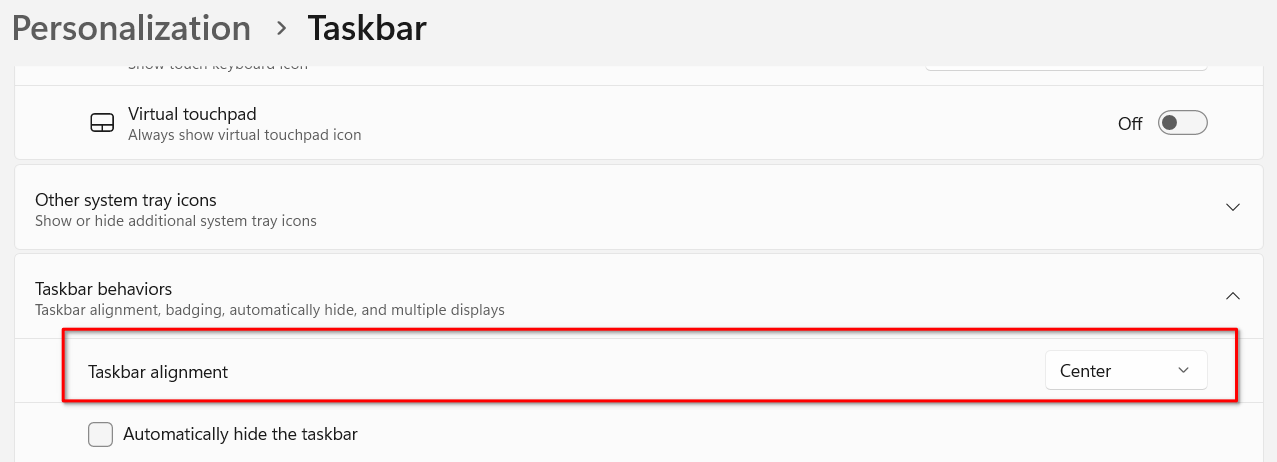
Windows doesn't display filename extensions by default, even though numerous malware epidemics have shown this is a bad idea. You can reenable extensions by going to "View > Show > File name extensions" in an open File Explorer window.
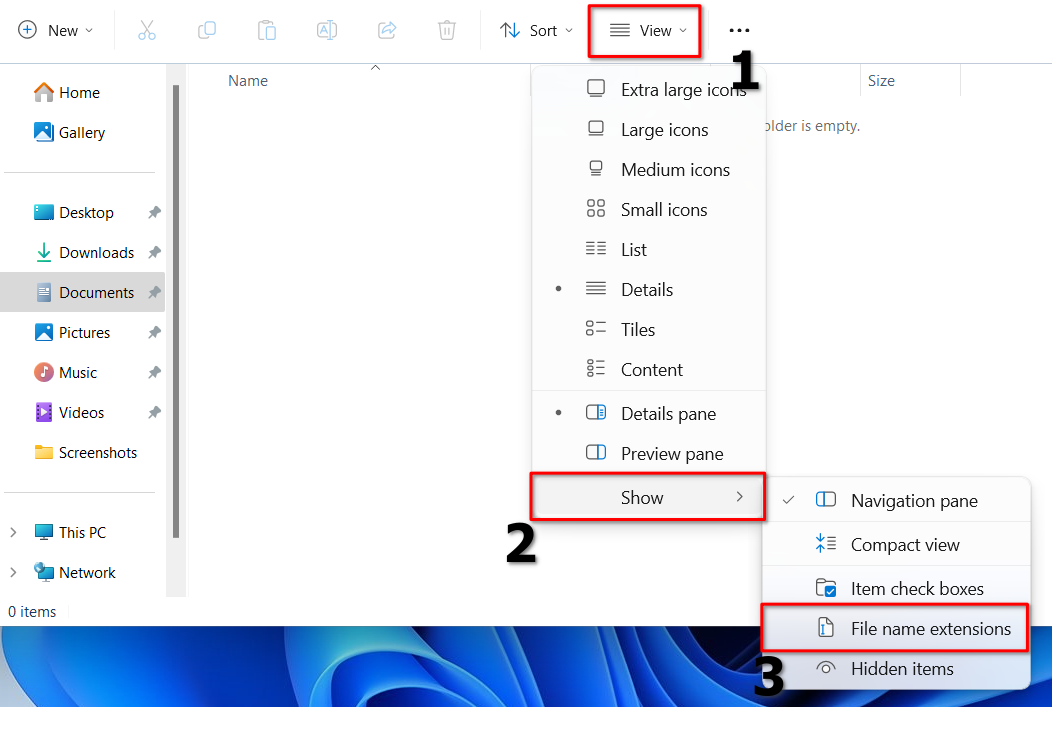
Microsoft will push their Edge browser on you since they want you to use their services. If you're not a huge fan of this, download Firefox for Windows. You can do this from terminal (without needing to even open Edge) with
Before you start using Firefox, you should open its settings and change some defaults. Unfortunately, Firefox still does some tracking by default, but at least you can disable it.
Microsoft now installs OneDrive by default on every Windows system. It's helpful if you plan to use it I guess, but otherwise it just takes up space and slows your computer down because it runs automatically at startup. The easiest way to uninstall it is through the old Control Panel > Uninstall or change a program.

Microsoft also automatically installs Microsoft Teams and some other things that automatically launch at startup. If you got your computer as a pre-built, it might have other bloatware installed that will also launch every time your computer turns on. To disable these head over to Task Manager and navigate to the Startup apps tab. Don't disable things related to drivers or Windows security.

Windows comes with a lot of pre-installed apps that you probably won't ever use. You can uninstall some of them from Settings at Apps > Installed apps, or from the Start menu by right-clicking on them.

Even if you turn off all of the settings in the OOBE, Windows still has a few default settings to track you. Disable them at "Privacy & security > General" in the Settings app.

This should reduce the amount of data Microsoft collects, but in general modern Windows really isn't the place to look for privacy.
Whew! We're done! If you've made it this far, it means I'm all out of things for you to change, and you hopefully have a Windows installation that is slightly less annoying to use. Now while you wait for Windows to finish installing updates, consider that you could have avoided most of this if only you had installed Linux instead...top
Windows Setup Tips
I got tired of looking up various things in random websites flooded with ads and bloat just to figure out how to turn off all the annoying ads and "features" enabled in Windows by default, so I decided to make this guide to have everything you need to do after installing Windows 10 or 11 in one place.
The guide focuses mostly on Windows 11 since it's the main one now, but most of it should apply to Windows 10 also. A few things might be moved around slightly between the versions though. I'd suggest going with Windows 11 nowadays just because Windows 10 will lose support in under a year as of writing. So much for the "last" Windows version.
Some Tips for Installing Windows
- The helpful tool Rufus can make Windows 11 USBs which automatically have TPM and hardware requirements bypassed and which do not require a Microsoft account. It is strongly recommended to use Rufus and a Windows 11 ISO instead of the Media Creation Tool to generate bootable Windows 11 media, because otherwise you will be required to connect to the Internet and sign in to a Microsoft account to continue setup.
- Even with workarounds, Windows 11 24H2 and later cannot run on processors lacking SSE4.2 instructions. This includes, but is not limited to, all Intel CPUs earlier than Nehalem and all AMD CPUs earlier than Bulldozer. There's no way to bypass this requirement.
- If you use a system this old, your options to stay supported after 2025 are a Windows 10 LTSC release or Linux.
- On Linux or macOS, don't try to use dd to copy the Windows ISO to a USB. It won't boot!
- When you install Windows, make sure you unplug all drives except the one you intend to install to. Otherwise, Windows may install its bootloader to another drive, meaning that if that drive is ever removed you will be left with an unbootable system.
- On most newer OEM computers, the product key is embedded in the device's BIOS and the installer will automatically detect it and install the appropriate edition of Windows. If this doesn't happen and Windows 10/11 was previously activated on the machine, ensure that you select the version (Home/Pro/etc.) that matches the old Windows installation. Windows should re-activate once it connects to the Internet. You'll have to activate if Windows 10 or 11 has never been activated on the machine before or if the version doesn't match.
- Windows 7 product keys used to work on Windows 10/11, but not anymore.
- Make sure you are not connected to the Internet when the Windows 11 OOBE starts. Otherwise you will be unable to create a local account, even if you wrote the USB image with Rufus. Politely decline whenever Windows suggests connecting to the Internet in the OOBE (barely-visible fine blue text in the corner).
- Don't forget to disable all of the tracking settings in the OOBE, and skip Cortana/OneDrive/location setup.
- Always make sure all of your hardware is set up properly in Device Manager. Windows Update usually doesn't automatically install everything! If there are any unknown devices, you might have to install the drivers via optional Windows updates, or manually from the manufacturer website.
Windows 10/11 First-Time Setup
Disable Bing Search in Start
Tired of searching for a document on your computer, only for Windows to just look it up on Bing? And even if you did want to do a Web search from the taskbar for some reason, it always opens the search in Bing and Microsoft Edge regardless of what your default browser/search engine is set to. Disable this annoying "feature" with a simple registry key.
Note that this is not possible through the group policy editor in any version of Windows; a similar setting exists but it doesn't work.
- First, type Win+R and in the Run dialog type "regedit".
- Navigate to the path Computer\HKEY_CURRENT_USER\Software\Policies\Microsoft\Windows.
- If the folder/key "Explorer" is not here, right click the Windows folder and select "New > Key". Name the new key "Explorer".
- Inside the key "Explorer" right click and select "New > DWORD Value (32-bit)". Name the new DWORD value "DisableSearchBoxSuggestions".
- Double-click the "DisableSearchBoxSuggestions" DWORD value and change its value from 0 to 1.

Don't add or modify any other registry keys. You'll need to restart the PC for this change to take effect.
Disable Windows Welcome Notification ads
"Windows welcome notifications" are basically full-screen ads that show up randomly when you start your PC. They usually try to convince you to switch to Microsoft Edge or sign into a Microsoft account or whatever else Microsoft wants to push on you today. There's no way to disable them when they pop up, and you can only dispel them for 3 days at a time. But you can get rid of these pesky notifications for good by simply unchecking a few boxes in Settings.

Navigate to "System > Notifications > Additional settings" in the Settings app to find this page.
Disable ads on the lock screen
Out of the box, Windows will show random web links and advertisements on the lock screen while the computer is locked. To disable this, go to "Personalization > Lock screen" in the Settings app.

The "Personalize your lock screen" setting will be set to "Windows spotlight". Change it to "Picture" and uncheck the new setting that appears. You can also set your own custom lock screen image from here, similar to setting a wallpaper.
If you want, you can also disable the widgets that appear on the lock screen by changing "Lock screen status" from "Weather and more" to "None".
Disable ads in Start
By default, Windows will show "Recommended" apps occasionally in the Start menu. To evict these uninvited guests from your Start menu, simply navigate to "Personalization > Start" in the Settings app.

Disable taskbar icons
Don't want useless widgets taking up space on the taskbar? You can customize what icons appear in the Taskbar at "Personalization > Taskbar" in the Settings app.

You can also get a cleaner look by doing away with the graphic that shows up in your Search bar by disabling Search Highlights in "Privacy & security > Search permissions".

Align taskbar left
Windows 11 changed where the Start button and taskbar icons appear to the center of the screen. If you'd rather not relearn decades of muscle memory for no reason, you can change it back at "Personalization > Taskbar" under "Taskbar behaviors".

Enable filename extensions
Windows doesn't display filename extensions by default, even though numerous malware epidemics have shown this is a bad idea. You can reenable extensions by going to "View > Show > File name extensions" in an open File Explorer window.

Install Mozilla Firefox browser
Microsoft will push their Edge browser on you since they want you to use their services. If you're not a huge fan of this, download Firefox for Windows. You can do this from terminal (without needing to even open Edge) with
wget -O FirefoxSetup.exe "https://download.mozilla.org/?product=firefox-latest&os=win&lang=en-US". Alternatively, download it here.Before you start using Firefox, you should open its settings and change some defaults. Unfortunately, Firefox still does some tracking by default, but at least you can disable it.
- Make Firefox your default browser (General > Startup).
- Disable "Recommend extensions as you browse" and "Recommend features as you browse" (General > Browsing)
- If you want, change "What should Firefox do with other files?" to "Ask whether to open or save files". This displays a confirmation whenever you download something, rather than automatically starting the download. (General > Applications)
- Disable "Sponsored shortcuts" and "Recommended stories" (Home > Firefox Home Content)
- Choose your preferred search engine (Search > Default Search Engine)
- Disable "Show trending search suggestions" (Search > Search Suggestions)
- Disable "Suggestions from sponsors" and "Improve the Firefox Suggest experience" (Search > Address Bar - Firefox Suggest).
- Disable unwanted search shortcuts (Search > Search Shortcuts)
- Enable "Strict" tracking protection (Privacy & Security > Enhanced Tracking Protection). You'll see a warning that this breaks sites, however I seldom encounter sites that have issues with it. It's easy to temporarily disable it if you ever do need to access a problematic site.
- Enable "Tell websites not to sell or share my data" (Privacy & Security > Website Privacy Preferences).
- Disable everything in "Firefox Data Collection and Use" (Privacy & Security > Firefox Data Collection and Use).
- Disable the Pocket extension by typing
about:configin the address bar. Accept the warning and search forextensions.pocket.enabled. Change its value to false using the toggle on the right side of the page. - From a new tab, unpin any unwanted pinned shortcuts by clicking the dots which appear when you hover over them and then Dismiss. Also remove the Getting Started bookmarks from the toolbar by right-clicking it and then clicking Delete Bookmark.
Uninstall OneDrive
Microsoft now installs OneDrive by default on every Windows system. It's helpful if you plan to use it I guess, but otherwise it just takes up space and slows your computer down because it runs automatically at startup. The easiest way to uninstall it is through the old Control Panel > Uninstall or change a program.

Turn off other startup apps
Microsoft also automatically installs Microsoft Teams and some other things that automatically launch at startup. If you got your computer as a pre-built, it might have other bloatware installed that will also launch every time your computer turns on. To disable these head over to Task Manager and navigate to the Startup apps tab. Don't disable things related to drivers or Windows security.

Uninstall Windows apps
Windows comes with a lot of pre-installed apps that you probably won't ever use. You can uninstall some of them from Settings at Apps > Installed apps, or from the Start menu by right-clicking on them.

Privacy settings
Even if you turn off all of the settings in the OOBE, Windows still has a few default settings to track you. Disable them at "Privacy & security > General" in the Settings app.

This should reduce the amount of data Microsoft collects, but in general modern Windows really isn't the place to look for privacy.
Fin
Whew! We're done! If you've made it this far, it means I'm all out of things for you to change, and you hopefully have a Windows installation that is slightly less annoying to use. Now while you wait for Windows to finish installing updates, consider that you could have avoided most of this if only you had installed Linux instead...









